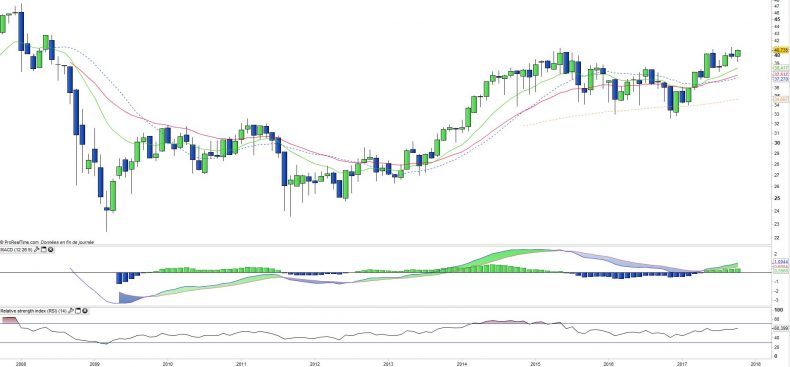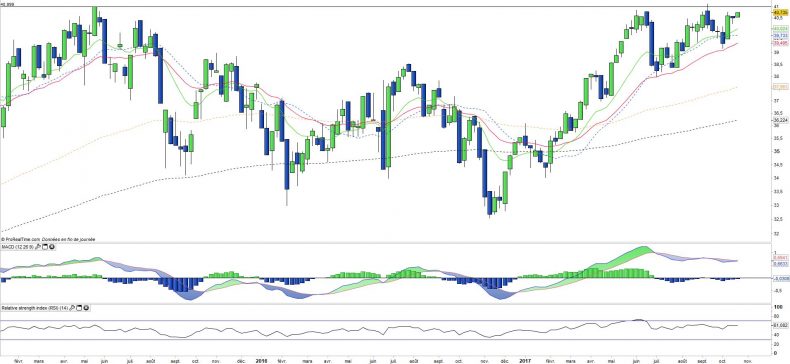Lyxor Stoxx 600 Utilities (UTI) - 24/10/2017
Short Term strategy : Positive (90%) / Trend +
Long Term strategy : Positive (95%) / Trend +
Characteristics of the ETF
The Lyxor UTI ETF (Utilities Europe), created in 08/2006, is listed in Euro on Euronext and seeks to replicate the STOXX600 Utilities Europe index composed of 29 European stocks of which approximately 24% are English, which implies a risk related to parity Euro - Pound Sterling that can be quite volatile in the Brexit period.
The costs of this ETF are 0.3% and the AUM approximately 46M €. Replication is indirect (via Swap) and dividends are capitalized.
Alternative ETFs: EXH9 (iShares, Euro), CU5 (Amundi, Euro), SYU (BNP Easy, Euro)
Index & components
UTI replicates the European Utilities sector in a broad sense, mainly with producers and / or distributors of electricity, but also with water distributors and utilities (such as Veolia).
We note, however, that this index is composed of only 29 values, so it is quite narrow while only the three most important values (National Grid, Iberdrola and Enel) account for about 35% of all and gathering the five largest values by adding Engie and E.ON, we arrive at about 50% of the weight of the index.
It also notes that English holdings represent 24% of the index which is not trivial in view of the potentially significant fluctuation of the £ against the Euro. Market capitalizations are high and close to € 40bn for Iberdrola, Enel, National Grid and Engie, this is a factor of inertia and compensates for the relative narrowness of the index. In addition, the stocks that make up this index have defensive characteristics and generally offer high dividends, volatility is quite low in normal times. Note the importance of the yield around 5% which strengthens the value side of the sector, however a number of stocks are highly indebted which can put their dividend at risk. The fact that a number of companies are "in transition" with asset rotations and very large investment programs makes dividends riskier than before, undermining their usual defensive status for a while.
The good industrial results of major players such as Engie, Iberdrola and Enel, as well as the cissions (RWE and EON), nevertheless awaken the stock market interest for the sector. Large operators are still in a phase of optimizing portfolios, towards more gas and renewables, and less coal and nuclear, but the transition takes time. The decline in oil, a deflationary factor likely to delay the rate hike, is a favorable factor for utilities, generally heavily indebted, who take advantage of low rates to refinance themselves cheaply.
In the long term, the recomposition of the portfolio and the optimization of the balance sheets are favorable elements.
Latest developments
After a -5.7% drop in 2016, a much lower performance than the Stoxx600 (+ 1.7%), the sector returned significantly higher in 2017 and posted a performance of + 14.6% (vs. +10 , 7% for the Stoxx600). The results are expected to improve significantly in 2018 due to rising electricity prices and higher consumption as a result of the economic recovery.
In addition, the low interest rate environment in Europe should continue as the ECB expects a very gradual normalization of its monetary policy in the absence of inflation. Most players are accelerating their transition with a portfolio that tends to focus more on gas and renewable energies (Engie, Iberdrola, Enel) whose marginal cost tends to fall, unlike nuclear power.
The sector is not very expensive despite prospects that are improving and a return that remains very attractive and increasingly sustainable. Distribution specialists who own infrastructure are well positioned for the new cycle that is coming.
Monthly data
The monthly chart shows a positive long-term trend, which has started a new bullish wave since the beginning of the year after a long correction in 2016. The upward crossing of the MACD and moving averages that are rising again make it likely overtaking the 2015 summit that is currently under attack.
The medium-term target is represented by the 2007/2008 summit at € 47, while the trend seems to be accelerating upwards.
Weekly data
On the weekly chart, we can see that the prices work the resistance of 41 € which should eventually hand over. This resistance has been hit four times, once in 2015 and it is now the third time in 2017.
The MACD which seems in a position to turn upward could give the necessary positive impetus to this bullish break out, which would give back index a significant medium-term upside potential.
ETF Objective
UTI is a UCITS compliant ETF that aims to track the benchmark index Stoxx Europe 600 Utilities Net Return (29 companies)
Characteristics
| Inception date | 25/08/2006 |
| Expense ratio | 0,30% |
| Issuer | Lyxor |
| Benchmark | Stoxx 600 Utilities |
| ISIN | FR0010344853 |
| Ticker | UTI |
| UCITS | Yes |
| EU-SD Status | Out of Scope |
| Currency | € |
| Exchange | Euronext Paris |
| Assets Under Management | 47 M€ |
| Replication Method | Indirect (swap) |
| Currency Risk | Yes |
| Dividend | Capitalization |
| PEA (France) | Yes |
| SRD (France) | Yes |
| Number of Holdings | 29 |
| Risk | 3/5 |
Country Breakdown
| United Kingdom | 24% |
| Spain | 20% |
| Italy | 19% |
| France | 16% |
| Germany | 13% |
| Others | 8% |
Sector Breakdown
| Utilities | 95% |
| Energy | 5% |
Top Ten Holdings
| Enel | 12% |
| Iberdrola | 12% |
| National Grid | 11% |
| Engie | 8% |
| E.On | 7% |
| SSE PLC | 5% |
| Veolia Environnement | 3% |
| RWE | 3% |
| Centrica | 3% |
| Snam | 3% |


